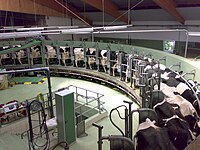
Photo from wikipedia
ABSTRACT Increased reproductive effort may lead to trade-offs with future performance and impact offspring, thereby influencing optimal current effort level. We experimentally enlarged or reduced litter size in mice during… Click to show full abstract
ABSTRACT Increased reproductive effort may lead to trade-offs with future performance and impact offspring, thereby influencing optimal current effort level. We experimentally enlarged or reduced litter size in mice during their first lactation, and then followed them through a successive unmanipulated lactation. Measurements of food intake, body mass, milk energy output (MEO), litter size and litter mass were taken. Offspring from the first lactation were also bred to investigate their reproductive success. In their first lactation, mothers with enlarged litters (n=9, 16 pups) weaned significantly smaller pups, culled more pups, and increased MEO and food intake compared with mothers with reduced litters (n=9, 5 pups). In the second lactation, no significant differences in pup mass or litter size were observed between groups, but mothers that had previously reared enlarged litters significantly decreased pup mass, MEO and food intake compared with those that had reared reduced litters. Female offspring from enlarged litters weaned slightly smaller pups than those from reduced litters, but displayed no significant differences in any of the other variables measured. These results suggest that females with enlarged litters suffered from a greater energetic burden during their first lactation, and this was associated with lowered performance in a successive reproductive event and impacted on their offspring's reproductive performance. Female ‘choice’ about how much to invest in the first lactation may thus be driven by trade-offs with future reproductive success. Hence, the ‘limit’ on performance may not be a hard physiological limit. These data support the ecological context hypothesis. Highlighted Article: Data from this paper indicate that there may be a ‘soft’ limit dependent on female ‘choice’ on energy allocation to their litters, rather than a ‘hard’, unbreachable limit defined by aspects of maternal physiology as is commonly assumed.
Journal Title: Journal of Experimental Biology
Year Published: 2018
Link to full text (if available)
Share on Social Media: Sign Up to like & get
recommendations!